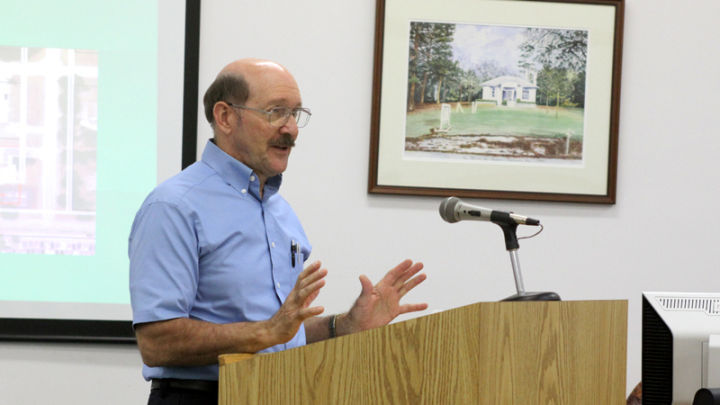
FELLSMERE — The Marian Fell Library sits alone in the center of an otherwise vacant piece of city-owned land on North Cypress Street – its only company is a new stormwater retention pond and the tennis and racquetball courts. But that could change now that the Fellsmere City Council, with input from the Planning and Zoning Commission, has given city staff some direction what to do with the property.
Council members envision several historic and significant homes keeping the library company. The homes would be relocated from sites elsewhere within city, helping to preserve Fellsmere’s architectural heritage.
Community Development Director Mark Mathes proposed to council members last week to have at least three homes moved to the site – one each of the Craftsman, Mission, and Florida Vernacular architectural styles.
The issue of preserving historic homes cropped up in recent years as more and more such homes have been torn down to make way for new construction or have fallen into such disrepair as to be unsalvageable.
Most recently, a Family Dollar store wanted to remove a historic, Mission-style home, from the corner of County Road 512 and N. Elm Street. The potential commercial development raised the specter of losing another significant home and prompted the council to discuss ways to preserve such homes.
To identify the remaining historically significant homes and help homeowners – if money is available – to restore and rehabilitate to them, the city has worked out a partnership with Habitat for Humanity.
In the event, however, a private owner decides on new construction, the council wants to have the option to relocate the home elsewhere for preservation, which resulted in the discussion on what to do with the property surrounding the Marian Fell Library.
The relocated homes would be repaired in keeping with their history and could be converted to public use.
The council discussed several possibilities to bring the plan to fruition, including an artist-in-residence program or inviting Indian River State College to expand. The college currently offers a couple pf programs at the library, but could use more space.
The homes could also be used for community meetings and events or for family reunions, weddings and other activities.
Vice Mayor Joel Tyson also told the council and commission that he had been approached by various residents who inquired about an official Fellsmere museum – a place to keep items from bygone days.
“I thought that was Marsh Landing,” quipped councilwoman Sara Savage. Marsh Landing Restaurant’s walls are lined with historic photos and various items from the city’s start and its tables are topped with preserved pages from the newspapers that once served Fellsmere.
Tyson said he’d like to see one of the homes be used in much the same way as the Old Sebastian School, which houses the Sebastian River Area Historical Society and museum.
Connie Ward, a volunteer for almost 12-years at the library, voiced support for the plan to relocate other homes to the site.
“The overall concept is a very nice one,” she said, explaining that having the homes lined up in an attractive way would help round out the property.
Fellsmere historian Rich Votapka also lent support to the proposal.
He urged the council to consider a medium-intensity plan that would allow for six or seven homes to be added to the site and maintain greenspace.
He also encouraged the council to – when it’s ready – cultivate a Fellsmere Historical Society-type group to be tasked with managing the campus and raising money to maintain the properties.
“I’m all for it, as a historian,” Votapka said.
Mathes presented three plans ranging in intensity from low to high. The low-intensity plan would accommodate just three homes, but would provide ample greenspace to reinstate the city’s historic grass tennis court.
The third option – the high intensity – could save the most homes, as many as 11, but would require the houses to be lined in two rows, facing each other instead of the community.
Passersby on N. Cypress would only see the backs of the homes unless they came onto the property.
The high-intensity use would also eat much of the greenspace between the homes and needed parking. Mayor Susan Adams threw her support behind the medium-intensity use, noting that it balances both goals – preserving homes and greenspace.
Dale Beaman, a member of the Planning and Zoning Commission, suggested staff merge the mid- and high-intensity plans, using the building layout from the medium intensity plan and the parking layout from the high intensity plan, to ensure there would be enough parking for whatever uses are assigned the historic homes.



